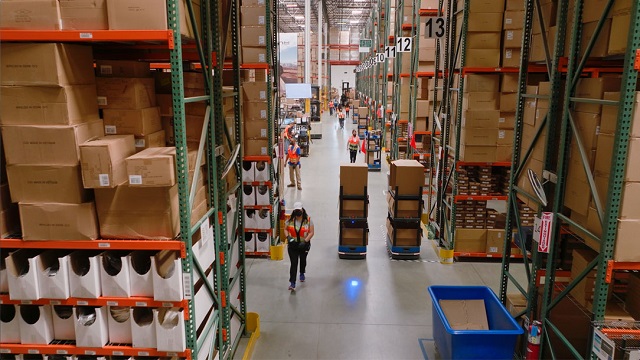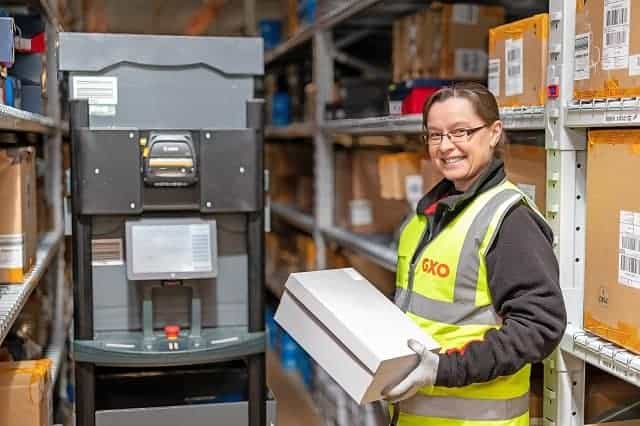Warehouse logistics is the heart of any supply chain operation, assimilating and dispatching goods to ensure availability and timely delivery. With more consumers turning to e-commerce, it’s important for businesses of all sizes to bolster the supply chain to handle the e-commerce business model. According to research conducted by BigCommerce, the top three factors that influence consumers’ online purchasing decisions are convenience, cost and free shipping. In fact, the National Retail Federation (NRF) found that 75% of consumers expect delivery to be free even for orders under $50.
Shipping costs are such an influential factor in buying decisions that 65% of consumers look up an online retailer’s free shipping thresholds before adding a single item to their shopping carts. Thirty-nine percent (39%) of consumers expect two-day shipping to be free, and 29% of consumers say they’ve backed out of making an online purchase when two-day shipping wasn’t free.
One of the best ways to reduce shipping costs and ensure fast delivery is by optimizing warehouse logistics.
What is warehouse logistics?

Warehouse logistics is the process of planning, operating and controlling the flow of goods in your warehouse to optimize costs and time and meet other business objectives. Warehouses are a significant component of the supply chain and should be aligned with both broader organizational goals as well as the supply chain overall. Planning and organizing inventory is a vital facet of warehouse logistics. Maintaining adequate manpower and machinery for operations is also essential, as well as the process for picking and shipping orders.
It takes considerable effort and resources — including financial resources, infrastructure resources and human capital — to operate a warehouse like a well-oiled machine. In this guide, we’ll discuss essential steps and key strategies for optimizing your operations across four essential stages in the warehouse logistics cycle (plan, operate, measure and optimize), including:
- Plan: Developing a warehouse logistics plan
- Operate: Warehouse logistics operations
- Measure: Measuring warehouse logistics performance
- Optimize: Optimizing warehouse logistics
These four sections cover everything you need to know about warehouse logistics from the initial phase to regular operations.
Plan: Developing a warehouse logistics plan
It is always advisable to have a viable plan in place before you hit the ground running. Without a plan that includes clear business objectives and a roadmap for achieving them, it’s impossible to know whether you hit your targets.
Gathering requirements

First, you need to ascertain the company’s warehouse needs. Some questions need to be answered to determine the warehouse requirements, including:
- Who are your customers?
- Where are they located?
- What is the order volume?
- What is the current solution employed?
- What is the cost of the current solution?
- What are the delivery times with the current solution?
- Will there be cost savings with the new warehouse?
- What is the timeframe for implementation?
- What operational efficiency are you looking for with a new warehouse?
These are some of the questions that need to be answered before making the final decision on moving forward with a new warehouse. Depending on your company’s unique business requirements, there may be other questions and considerations to weigh.
This step helps you clearly define the needs, requirements, benefits and timeline for implementation. You need to estimate the cost of operations including all the elements of running the warehouse, the cost or time savings obtained by investing in a new warehouse and the break-even point for the project.
It is possible that this analysis may not justify a dedicated warehouse. In that case, working with a reliable third-party logistics operator may better serve your needs. The top third-party logistics providers have spent years perfecting their operations, allowing companies to tap into their expertise and get optimal performance at a minimized cost compared to maintaining in-house warehousing and logistics operations. Alternatively, you may be able to extend the lifespan of your warehouse by implementing flexible automation solutions.
Identifying a location
Once you have determined the need for a warehouse, you need to identify a suitable location. The questions you have answered during the requirements gathering phase will come in handy here. Once you know where your customers are, it is easy to identify the best warehouse location to serve your customers. Keep in mind that it’s often more profitable to serve some customers than others, so you may want to prioritize the needs of the customers who create the most revenue for your business. For example, you may choose a location based on proximity to your best or longest-term customers, allowing you to deliver goods to those customers faster than short-term or occasional customers. Tools based on Geographic Information Systems (GIS) are available to identify the best location for your warehouse.
Another factor to consider is whether you are building a warehouse from the ground up, using an existing warehouse or repurposing another facility to function as a warehouse. All of this comes down to your warehousing requirements and cost concerns. You should also collaborate with your company’s finance department to identify the best possible solution from a financial perspective. Purchasing, renting and leasing have different implications on the balance sheet, and the finance department is better poised to identify what is best for the company’s long-term financial health. At the same time, your warehousing requirements should not be compromised. Meeting both financial and logistical objectives at the same time is a delicate balancing act, making transparency and open communication between various departments necessary.
Mapping your warehouse
Mapping a warehouse is an essential exercise for determining what goes where and how operations are handled. Order picking activities are considered the most labor-intensive activity in a warehouse, comprising as much as 55% of warehouse operating costs, and mapping your warehouse can help to streamline this essential business function. The warehouse mapping process includes:
- Assessing the space
- Labeling the space (including aisles, racks, shelves, containers or bins, etc.)
- Estimating traffic
- Implementing the right racking system
- Choosing the best order picking carts to meet the warehouse’s requirements
- Implementing inventory management software
Mapping your warehouse is a crucial step that should not be missed. Without a well-mapped warehouse, your logistics operation is bound to be chaotic as there is no blueprint to operate on.
Operate: Warehouse logistics operations
After developing a robust plan, you have to back it up with action. You have to hire employees, establish a management structure, integrate the warehouse with the rest of the supply chain and ramp up operations to the full potential. If you are switching from an existing solution with a third-party logistics provider to a dedicated warehouse, you need to decouple from the existing service provider in a slow and staggered manner.
However robust the warehousing plan is, you should not discount the possibility of disruptions. Should disruptions occur shortly after beginning operations, the current service provider can act as a backup plan. Below, we’ll take a look at the key elements in ensuring smooth warehouse logistics operations.
Competent warehouse manager

It may sound like a no-brainer, but some bottlenecks in supply chains can be traced back to incompetent warehouse management. A demonstrated ability in a candidate’s previous role is perhaps the most important consideration when evaluating warehouse management candidates, although years of experience shouldn’t be discounted. The warehouse manager should know all the ins and outs of the facility and location. They also should have adequate knowledge of the specialized equipment and procedures that support streamlined and efficient warehouse operations. Because a not-insignificant number of problems that arise in a warehouse are people-related, exceptional interpersonal skills are also a must for highly qualified warehouse managers.
Clear targets and future
Everyone in the warehouse must be aware of the operational goals. Employees should not feel as though they are performing routine tasks in return for a salary, but that they’re making valuable contributions to a larger strategy to improve the business. Employees should feel that they are valued and essential elements in achieving the aims of the organization.
Technology and growth
Adopting the newest technologies without determining whether they support your processes can cost money and hinder operational efficiency. When technology is utilized in alignment with the business’s needs and requirements, it can bolster productivity and even boost employee morale by making your warehouse associates’ jobs easier. Today it is impossible to operate a warehouse with what can be held in the brains of warehouse managers or even spreadsheets. Specialized software solutions are available for every need in the market. Taking the time to research and evaluate technology solutions to find the right solutions to meet the company’s requirements is time well-spent.
Employee satisfaction
Warehouse operations are heavily dependent on employees. Labor comprises nearly 65% of warehouse operating costs, so it is crucial that your employees are performing to the best of their abilities. Your employees should wholeheartedly accept the vision of your company and strive towards the future, but your company’s mission and vision must be something your employees can get behind.
The manager you hire becomes vital in this respect. Employees do not want to work with a phantom managerial department but want to interact with a manager who can empathize with them. So, it is important to hire a manager who is up to the task of managing people and their expectations.
Measure: Measuring warehouse logistics performance
Simply having a warehouse up and running isn’t enough to compete in today’s competitive landscape; measuring performance and striving for continuous improvement is a must. If you do not measure, everything might seem to be running smoothly until the breaking point is reached, bringing your warehouse logistics operations to a halt. Because you have no way of knowing if you’re meeting your objectives, it’s difficult to set targets for the future.

There are many indicators that can be measured to monitor the performance of warehouse logistics, including:
- Inventory metrics
- Receiving metrics
- Put away metrics
- Fulfillment metrics
- Warehouse safety metrics
What you need to measure most are key performance indicators (KPI), which are essential metrics that measure the most significant data that can provide insights into the overall health of your warehouse logistics operations. Here are some of the most valuable KPIs for warehouse operations.
Shrinkage
Shrinkage refers to the percentage of inventory that is recorded but not physically present. This indicator reveals whether you have a problem with inventory damage, theft, miscounting or supplier fraud. Here’s how to calculate it:
Shrinkage = (Cost of recorded inventory – Cost of physical inventory)/ Cost of recorded inventory
Inventory turnover ratio
This indicator shows how many times inventory was sold and replaced in a given period. The inventory turnover ratio tells you how fast you sell your inventory. It can be tested against the industry averages to check the performance and measured during specific periods to provide insight into seasonal demand and other fluctuations. Here’s how to calculate it:
Inventory turnover ratio = Sales /Average cost of goods sold/Average inventory
Cost of carrying inventory
The cost of carrying inventory indicates the percentage of overall inventory costs spent on inventory overhead every year. The aim is to reduce this number as much as possible, which can be done by eliminating obsolete or slow-moving inventory. Calculate the cost of carrying inventory with this equation:
Cost of carrying inventory = Carrying cost/Overall inventory cost
Cost per line
This metric is the cost to receive a line item on a purchase order. When this number is high, it indicates the warehouse receiving process is less efficient and needs improvement. Here’s how to calculate the cost per line:
Cost per line = Total cost of receiving/Total line items
Receiving efficiency
This KPI represents the inventory received per man-hour worked. It is a measure of the productivity of employees in the receiving area. Sometimes, low receiving efficiency can be rectified with the use of specialized tools or equipment. Calculate receiving efficiency by using this equation:
Receiving efficiency = Volume/number of man-hours
Receiving cycle time
Receiving cycle time is a KPI that indicates the time taken to process delivery at the receiving end. To rectify a high number on this indicator or a long time to process, the number of deliveries can be reduced or rescheduled. Here’s how to calculate it:
Receiving cycle time = Total time for delivery/Number of deliveries
Put away accuracy rate
Put away accuracy rate is measured when the received items are put away. It is the percentage of items put away accurately the first time. Calculate put away accuracy rate using this equation:
Put away accuracy rate = Inventory put away correctly/Total inventory put away
Put away cycle time
Put away cycle time is the average time taken to put away an item after receiving it. There are several ways to improve this number, such as rearranging the warehouse, training employees to complete put away tasks more efficiently and implementing automation solutions such as collaborative mobile robots. Here’s how to calculate put away cycle time:
Put away cycle time = Total time for put away/Total time
Picking accuracy
This metric determines the accuracy during order picking. To improve this indicator, you can train employees, introduce a better process or introduce automation. Calculate picking accuracy using this equation:
Picking accuracy = ((Total number of orders – Incorrect item returns)/total number of orders) x 100
Rate of customer returns
The rate of customer returns is the ratio of products returned to the number of items sold. Ideally, this number should be zero, but it’s nearly impossible to achieve a zero rate of customer returns. When this number is high, you need to investigate the reasons for returns and identify if there is a larger theme for returns that could be rectified. Here’s how to calculate the rate of customer returns:
Rate of customer returns = Items returned/Items sold
In addition to these KPIs, you should measure safety indicators like time since the last accident, time lost due to injury and accidents per year. Warehouse operators should identify which of these indicators are the most significant in meeting business objectives and measure those that make the biggest impact.
Optimize: Optimizing warehouse logistics
Measuring warehouse logistics KPIs is the first step in optimizing your operations. Measurement is used to formulate objectives for optimization. For instance, if your rate of customer returns is desirable but picking accuracy is too low, your objectives should focus on strategies for improving order picking accuracy rather than reducing returns.
The four key areas for optimizing warehouse logistics include receiving, put away, order picking and safety. Training employees to perform tasks with greater accuracy and efficiency always contributes to better results. Sometimes, flawed processes can be the reason for sub-optimal performance. In such cases, the process should be streamlined with continued monitoring of the corresponding KPI to track the impact of process improvements. Implementing the right technologies also adds to warehouse logistics efficiency. Automated warehouse picking, for instance, can dramatically improve warehouse order picking efficiency.
Warehouse logistics optimization is an ongoing process. There will always be something that can be improved for better results. Choosing the functions and processes to optimize should be based on the potential impact on overall warehouse logistics operations. If you achieve optimal performance for one KPI, move on to the next and seek other areas to improve. Perfection is always elusive, so set clear objectives and targets that indicate when those goals are achieved. Otherwise, you may end up spending time on marginal improvements that don’t significantly contribute to overall operational efficiency.
Learn more about how investing in smart, flexible automation solutions like collaborative robots can help transform your fulfillment operations while providing the flexibility you need to meet increased demand and reduce costs by downloading our white paper, The Business Case for Collaborative Mobile Robotics.


